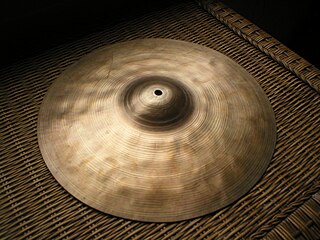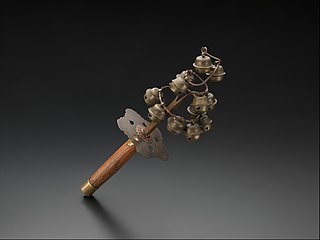Related Research Articles

Alexander Graham Bell was a Scottish-born inventor, scientist and engineer who is credited with patenting the first practical telephone. He also co-founded the American Telephone and Telegraph Company (AT&T) in 1885.

A cymbal is a common percussion instrument. Often used in pairs, cymbals consist of thin, normally round plates of various alloys. The majority of cymbals are of indefinite pitch, although small disc-shaped cymbals based on ancient designs sound a definite note. Cymbals are used in many ensembles ranging from the orchestra, percussion ensembles, jazz bands, heavy metal bands, and marching groups. Drum kits usually incorporate at least a crash, ride, or crash/ride, and a pair of hi-hat cymbals. A player of cymbals is known as a cymbalist.

Michael Gordon Oldfield is a British musician, songwriter, and producer best known for his debut studio album Tubular Bells (1973), which became an unexpected critical and commercial success. Though primarily a guitarist, Oldfield plays a range of instruments, which includes keyboards, percussion, and vocals. He has adopted a range of musical styles throughout his career, including progressive rock, world, folk, classical, electronic, ambient, and new age music.

A telephone is a telecommunications device that permits two or more users to conduct a conversation when they are too far apart to be easily heard directly. A telephone converts sound, typically and most efficiently the human voice, into electronic signals that are transmitted via cables and other communication channels to another telephone which reproduces the sound to the receiving user. The term is derived from Greek: τῆλε and φωνή, together meaning distant voice. A common short form of the term is phone, which came into use early in the telephone's history.

The glockenspiel or bells is a percussion instrument consisting of pitched aluminum or steel bars arranged in a keyboard layout. This makes the glockenspiel a type of metallophone, similar to the vibraphone.

The Liberty Bell, previously called the State House Bell or Old State House Bell, is an iconic symbol of American independence, located in Philadelphia. Originally placed in the steeple of the Pennsylvania State House, the bell today is located across the street in the Liberty Bell Center in Independence National Historical Park. The bell was commissioned in 1752 by the Pennsylvania Provincial Assembly from the London firm of Lester and Pack, and was cast with the lettering "Proclaim LIBERTY Throughout all the Land unto all the Inhabitants Thereof", a Biblical reference from the Book of Leviticus. The bell first cracked when rung after its arrival in Philadelphia, and was twice recast by local workmen John Pass and John Stow, whose last names appear on the bell. In its early years, the bell was used to summon lawmakers to legislative sessions and to alert citizens about public meetings and proclamations.

Tubular bells (also known as chimes) are musical instruments in the percussion family. Their sound resembles that of church bells, carillon, or a bell tower; the original tubular bells were made to duplicate the sound of church bells within an ensemble. Each bell is a metal tube, 30–38 mm (1+1⁄4–1+1⁄2 in) in diameter, tuned by altering its length. Its standard range is C4–F5, though many professional instruments reach G5. Tubular bells are often replaced by studio chimes, which are a smaller and usually less expensive instrument. Studio chimes are similar in appearance to tubular bells, but each bell has a smaller diameter than the corresponding bell on tubular bells.

A bell is a directly struck idiophone percussion instrument. Most bells have the shape of a hollow cup that when struck vibrates in a single strong strike tone, with its sides forming an efficient resonator. The strike may be made by an internal "clapper" or "uvula", an external hammer, or—in small bells—by a small loose sphere enclosed within the body of the bell.

Charles Sumner Tainter was an American scientific instrument maker, engineer and inventor, best known for his collaborations with Alexander Graham Bell, Chichester Bell, Alexander's father-in-law Gardiner Hubbard, and for his significant improvements to Thomas Edison's phonograph, resulting in the Graphophone, one version of which was the first Dictaphone.

A church bell in Christian architecture is a bell which is rung in a church for a variety of religious purposes, and can be heard outside the building. Traditionally they are used to call worshippers to the church for a communal service, and to announce the fixed times of daily Christian prayer, called the canonical hours, which number seven and are contained in breviaries. They are also rung on special occasions such as a wedding, or a funeral service. In some religious traditions they are used within the liturgy of the church service to signify to people that a particular part of the service has been reached. The ringing of church bells, in the Christian tradition, is also believed to drive out demons.
A handbell is a bell designed to be rung by hand. To ring a handbell, a ringer grasps the bell by its slightly flexible handle – traditionally made of leather, but often now made of plastic – and moves the arm to make the hinged clapper strike the inside of the bell. An individual handbell can be used simply as a signal to catch people's attention or summon them together, but handbells are also often heard in tuned sets.

Suzu are round, hollow Japanese Shinto bells that contains pellets that sound when agitated. They are somewhat like a jingle bell in form, though the materials produce a coarse, rolling sound. Suzu come in many sizes, ranging from tiny ones on good luck charms to large ones at shrine entrances. Suzu are, however, classified as small bells, since big bells are referred to as kane. The former is associated with Shinto and shrines while the latter is related to Buddhist temples and ceremonies.

Visible Speech is a system of phonetic symbols developed by British linguist Alexander Melville Bell in 1867 to represent the position of the speech organs in articulating sounds. Bell was known internationally as a teacher of speech and proper elocution and an author of books on the subject. The system is composed of symbols that show the position and movement of the throat, tongue, and lips as they produce the sounds of language, and it is a type of phonetic notation. The system was used to aid the deaf in learning to speak.

The invention of the telephone was the culmination of work done by more than one individual, and led to an array of lawsuits relating to the patent claims of several individuals and numerous companies.

Russian Orthodox bell ringing has a history starting from the baptism of Rus in 988 and plays an important role in the traditions of the Russian Orthodox Church.

A "ring of bells" is the name bell ringers give to a set of bells hung for English full circle ringing. The term "peal of bells" is often used, though peal also refers to a change ringing performance of more than about 5,000 changes.

Big Ben is the nickname for the Great Bell of the Great Clock of Westminster, at the north end of the Palace of Westminster in London, England, and the name is frequently extended to refer also to the clock and the clock tower. The official name of the tower in which Big Ben is located was originally the Clock Tower, but it was renamed Elizabeth Tower in 2012 to mark the Diamond Jubilee of Elizabeth II.

A jingle bell or sleigh bell is a type of bell which produces a distinctive 'jingle' sound, especially in large numbers. They find use in many areas as a percussion instrument, including the classic sleigh bell sound and morris dancing. They are typically used as a cheaper alternative to small 'classic' bells.

Ghanta is the Sanskrit term for a ritual bell used in Hinduistic religious practices. The ringing of the bell produces what is regarded as an auspicious sound. Hindu temples generally have one metal bell hanging at the entrance and devotees ring the bell while entering the temple which is an essential part in preparation of having a darshan. A bell is also rung by poojari during Pūjā or Yajna – during the waving of light, burning of incense in front of the deity, while bathing the deity and while offering food or flowers. There are bells specially made to produce the long strains of the sound Aum.

Bonshō, also known as tsurigane or ōgane are large bells found in Buddhist temples throughout Japan, used to summon the monks to prayer and to demarcate periods of time. Rather than containing a clapper, bonshō are struck from the outside, using either a handheld mallet or a beam suspended on ropes.
References
- ↑ Maclagan, Susan J (2009). A dictionary for the modern flutist. Scarecrow Press. p. 15. ISBN 9780810867284.